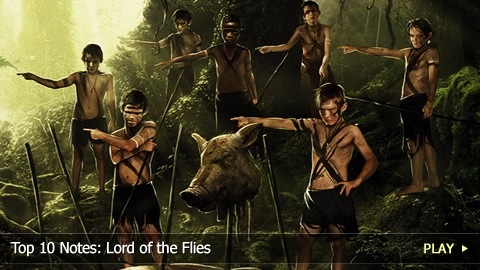Top 10 Notes: Lord of the Flies

It’s one of the most famous dystopian novels and it’s about a group of boys trapped on a deserted island. Welcome to WatchMojo.com and IN THIS INSTALLMENT OF MOJONOTES, we’ll be exploring ten things you should know about William Golding’s “Lord of the Flies.”
#10: About the Author
Born in 1911 in Cornwall, England, William Golding published his first book of “Poems” shortly after university. Following some time in the Royal Navy and as a teacher, he published his first novel in 1954. Though he wrote plays and non-fiction works, he’s most known for his prize-winning novels. He died in 1993.
#9: Influences and Inspirations
R.M. Ballantyne’s 1858 novel “The Coral Island: A Tale of the Pacific Ocean,” inspired Golding’s dystopian take in “Lord of the Flies.” His novel is also an allegory that uses the relationships between the stranded boys to represent real-life situations, especially the differences between civilization and nature.
#8: Settings and Era
Set on an island in the Pacific Ocean, the novel takes place during an imagined nuclear war during an unknown time. While it’s uninhabited, the island encompasses a dark and dangerous forest, a beach, a lagoon, reefs, mountains and an area called Castle Rock.
#7: Plot
Narrated by an unknown third-person, “Lord of the Flies” follows a group of preteen British boys left to fend for themselves after their plane crashes on a deserted island. After rallying the boys together using a conch, Ralph is voted chief by all except for the choirboys and their leader Jack Merridew. Along with Simon, Ralph and Jack attempt to organize the boys to ensure their survival. Instead, the group mocks the overweight Piggy and is consumed by fears of a reported beast. As Ralph and Jack struggle for power, the boys miss an opportunity to be saved. Jack then takes his supporters to Castle Rock to make sacrifices to the beast. Meanwhile, Simon experiences visions from a pig head he believes is the “Lord of the Flies” and is accidentally killed. The boys’ continue their savagery by murdering Piggy, hunting for Ralph and setting the forest on fire. It’s only when a naval vessel comes to their rescue that the boys realize what they’ve become.
#6: Ralph
Because he was the first to bring the boys together, Ralph is elected to be leader. He demonstrates his intelligence and leadership abilities by quickly taking control and declaring that a smoke signal should be maintained to secure their rescue. Though he’s brave and rational, he’s still a kid and still has his flaws: he laughs when Piggy’s being teased, enjoys hunting pigs and participates in Simon’s murder. Ralph also represents the evil inside of us and how power can corrupt.
#5: Jack Merridew
Though Jack is a natural leader, he’s also a dark person that fully embraces his violent nature. His transformation from hunter to beast, which is amplified by face paint and the leading of ritual dances, causes much tension in the group. Jack doesn’t only split up the boys but leads his supporters to murder. He represents human nature’s irrationality and their basic animal instincts.
#4: Piggy and Simon
Though he’s the smartest and most rational survivor, the fat, glasses-wearing Piggy is also the target of the boys’ bullying. He believes in the rules of civilization and continues to do so even though Jack’s tribe steals his glasses. Often consumed by dreams and hallucinations, Simon is a positive and peaceful character who’s in tune with nature. Though he tries to reveal the truth about the beast to the boys after experiencing visions, he’s mistaken for the beast and killed. He represents the loss of innocence.
#3: Values and Themes
The novel explores themes such as the human desire for power, organization through civilized living and our moral and psychological struggles. It also looks at the idea of what’s best for the individual versus most of a community as well as our natural instincts versus what we learn from society and our environment.
#2: Modern Popularity
Because of its controversial themes, “Lord of the Flies” wasn’t initially a best-seller. However, its importance and relevance were recognized within the next few years; it didn’t only start flying off shelves but was quickly incorporated into many school programs.
#1: Adaptations
In addition to a radio dramatization and its influence on other art forms, the novel has lent itself to several screen adaptations. This includes the well-received and Golding-approved 1963 version and the 1990 thriller.
Do you agree with our list? What’s your favorite piece of “Lord of the Flies” trivia? With new top 10s published daily, be sure to subscribe to WatchMojo.com.


 1
1
 0
0
 report
report

 0
0
 0
0
 report
report
